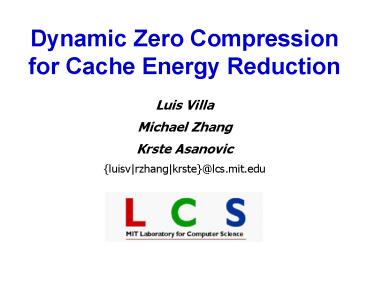Dynamic Zero Compression for Cache Energy Reduction PowerPoint PPT Presentation
Title: Dynamic Zero Compression for Cache Energy Reduction
1
Dynamic Zero Compression for Cache Energy
Reduction
- Luis Villa
- Michael Zhang
- Krste Asanovic
- luisvrzhangkrste_at_lcs.mit.edu
2
Conventional Cache Structure
Address Decoder
- Energy Dissipation
- Bitlines (75)
- Decoders
- I/O Drivers
- Wordlines
I/O
3
Existing Energy Reduction Techniques
128
32
- Sub-banking
- Hierarchical Bitlines
- Low-swing Bitlines
- Only for reads, writes performed full swing.
- Wordline Gating
gwl
lwl
lwl
SRAM Cells
SRAM Cells
Address Decoder
Offset Dec.
Offset Dec.
Sense Amps
Sense Amps
addr
offset
offset
I/O
BUS
4
Asymmetry of Bits in Cache
- gt70 of the bits in D-cache accesses are 0s
- Measured from SPECint95 and MediaBench
- Examples small values, data types
- Related work with single-ended bitlines
- Tseng and Asanovic 00 --- Used in register
file design with single-ended bitlines. - Chang et. al. 99 --- Used in ROM and small
RAM with single-ended bitlines.
- Differential bitlines preferred in large SRAM
designs. - Better Noise Immunity
- Faster Sensing
5
Dynamic Zero Compression
- Zero Indicator Bit
- One bit per grouping of bits
- Set if bits are zeros
- Controls wordline gating
6
Data Cache Bitline Swing Reduction
Bitline Swing Reduction
Calculation includes the bitline swings
introduced by ZIB
7
Hardware Modifications
- Zero Indicator Bit
- Wordline Gating Circuitry
- Sense Amplifier
- CPU Store Driver
- Cache Output Driver
8
ZIB and Wordline Gating Circuitry
9
Sense Amplifier Modification
- Zero-valued data
- Not driven onto bus
- Not in critical path
- ZIB read w/o delay
BUS
10
CPU Store and Cache Output Drivers
Reduce Data Bus Energy Dissipation
11
Area Overhead
- Area Overhead 9
- Zero-Indicator-Bits
- Sense Amplifiers
- WLG Circuitry
- I/O Circuitry
12
Delay Overhead
- No delay overhead for writes
- Zero check performed in parallel with tag check
- 2 F04 gate-delays for reads
- A pessimistic 7 worst case delay
13
Data Cache Energy Savings
- Savings obtained for a low-power cache with
sub-banking, wordline gating, and low-swing
bitlines
of Energy Savings
14
Bits Distribution for Instruction Cache
- Zeros are not as prevalent in I-Cache.
- Use a recoding scheme to increase the zero-byte
in I-cache. - Panich 99 --- IWLG technique that compacts the
instructions. - Use two-address form when src reg dest reg
- Shorter immediates
- Three different instruction length short,
medium, long - Gate the unused portion of the instruction to
avoid bitline swing - Faster read-out for top two bytes (opcode, reg.
acc., inter-locks)
15
IWLG to Dynamic Zero Compression
- Adopting IWLG technique for Dynamic Zero
Compression - Small modification on instruction format
- Use 8-8-8-8 instead of 16-7-9
- Upper two byte are zero-detected
- Lower two bytes are usage-detected
- Able to eliminate bitline swings of zero-valued
bytes in 2 upper bytes - Example Opcode 000000
- Slower than IWLG due to wordline gating in the
critical path
16
Instruction Cache Bit Swing Reduction
Reduction of Bitline Swings
17
Instruction Cache Energy Savings
Energy Savings
18
Conclusion
- A novel hardware technique to reduce cache
energy by eliminating the access of zero bytes. - Small area and delay overhead
- Area 9, Delay 2 F04 gate-delays
- Average energy saving D-Cache 26, I-
Cache18 - Processor wide 10 for typical embedded
processors - Completely orthogonal to existing energy
reduction techniques
- Dynamic Zero Compression is applicable to
- Second level caches
- DRAM
- Datapath Canal et. al. Micro-33
19
Thank You!
- http//www.cag.lcs.mit.edu/scale/

